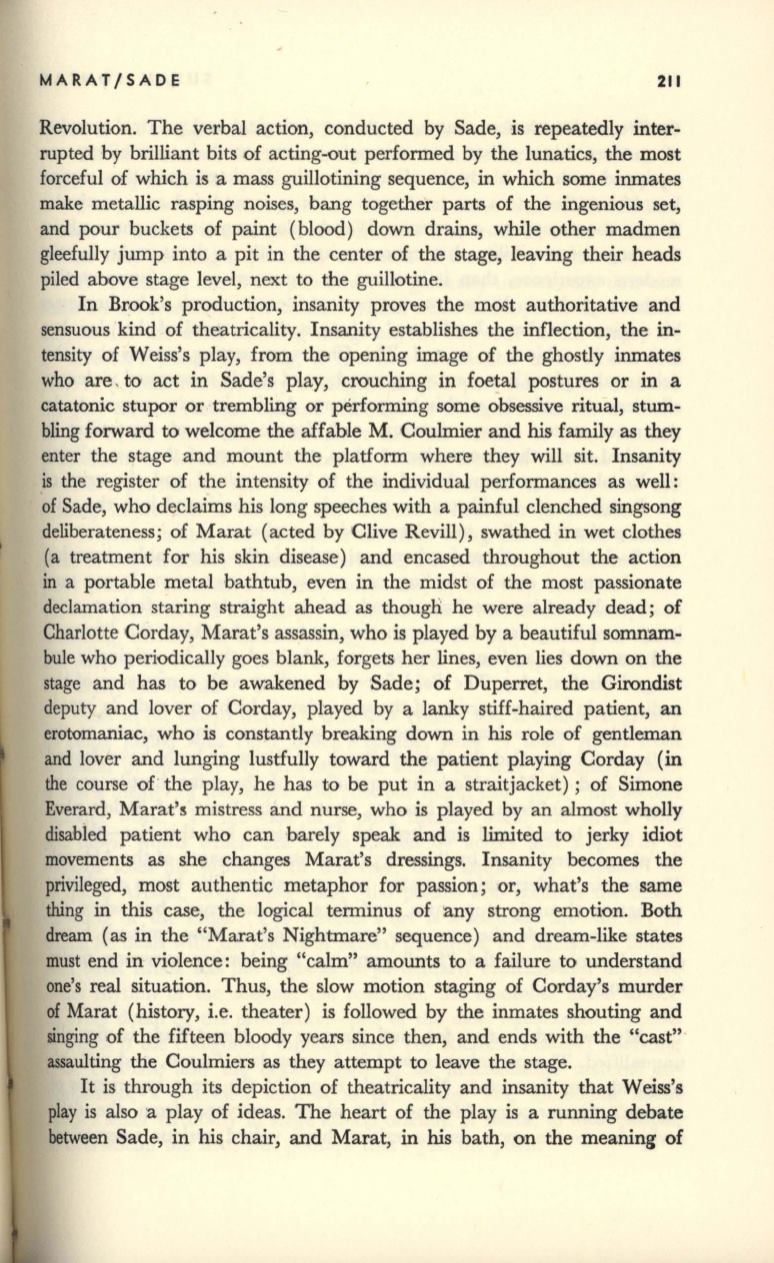
MARAT/SADE
211
Revolution. The verbal action, conducted by Sade, is repeatedly inter–
rupted by brilliant bits of acting-out performed by the lunatics, the most
forceful of which is a mass guillotining sequence, in which some inmates
make metallic rasping noises, bang together parts of the ingenious set,
and pour buckets of paint (blood) down drains, while other madmen
gleefully jump into a pit in the center of the stage, leaving their heads
piled above stage level, next to the guillotine.
In Brook's production, insanity proves the most authoritative and
sensuous kind of theatricality. Insanity establishes the inflection, the in–
tensity of Weiss's play, from the opening image of the ghostly inmates
who are . to act in Sade's play, crouching in foetal postures or in a
catatonic stupor or trembling or performing some obsessive ritual, stum–
bling forward
to
welcome the affable M. Coulmier and
his
family as they
enter the stage and mount the platform where they
will
sit. Insanity
is the register of the intensity of the individual performances as well:
of Sade, who declaims his long speeches with a painful clenched singsong
deliberateness; of Marat (acted by Clive Revill), swathed in wet clothes
(a treatment for his skin disease) and encased throughout the action
in
a portable metal bathtub, even in the midst of the most passionate
declamation staring straight ahead as though he were already dead; of
Charlotte Corday, Marat's assassin, who is played by a beautiful somnam–
bule who periodically goes blank, forgets her lines, even lies down on the
stage and has to be awakened by Sade; of Duperret, the Girondist
deputy and lover of Corday, played by a lanky stiff-haired patient, an
erotomaniac, who is constantly breaking down in his role of gentleman
and lover and lunging lustfully toward the patient playing Corday (in
the course of the play, he has
to
be put in a straitjacket); of Simone
Everard, Marat's mistress and nurse, who is played by an almost wholly
disabied
patient who can barely speak and is limited to jerky idiot
movements as she changes Marat's dressings. Insanity becomes the
privileged, most authentic metaphor for passion; or, what's the same
thing in this case, the logical terminus of any strong emotion. Both
dream (as in the "Marat's Nightmare" sequence) and dream-like states
must end in violence: being "calm" amounts to a failure to understand
one's real situation. Thus, the slow motion staging of Corday's murder
of
Marat (history, i.e. theater) is followed by the inmates shouting and
singing of the fifteen bloody years since then, and ends with the "cast"
assaulting the Coulmiers as they attempt to leave the stage.
It is through its depiction of theatricality and insanity that Weiss's
play is also a play of ideas. The heart of the play is a running debate
between Sade, in his chair, and Marat,
in
his bath, on the meaning of


